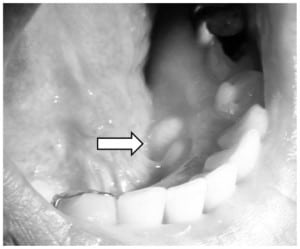| Author | Affiliation |
|---|---|
| Sarah Unterman, MD | Sarah Unterman, Jesse Brown VA Medical Center, Chicago, IL |
| Margaret Fitzpatrick, MD | Sarah Unterman, Jesse Brown VA Medical Center, Chicago, IL |
A 61-year-old man with a history of diabetes, hypertension, hyperlipidemia and polysubstance abuse presented to the emergency department complaining of bony growths on his lower jaw. He had noticed these growths intermittently in the past. He reported pain only when his dentures were in place and food lodged against the growths. The patient denied ulceration, bleeding and drainage. He reported good compliance with dental care. On exam he had sublingual bony-appearing growths covered in normal oral mucosa. There was no lymphadenopathy. The growths were nontender and without discharge or fluctuance.
Torus mandibularis is a bony sublingual protuberance, typically near the canine and premolar teeth.1 The etiology of tori is unclear. Possible causes include masticatory hyperfunction, continued bone growth, genetic factors and environmental factors such as diet.1,2 The prevalence of tori has been estimated from 12.3% to 26.9% with an average age of onset typically in the fourth decade of life, and an increased prevalence in males.2
Tori tend to grow gradually, are usually nodular, and the majority remain less than 2mm in size.2They may be either unilateral or bilateral and singular or multiple.2 Tori are usually asymptomatic, but patients may present with ill-fitting dental prostheses, mucosal ulceration or concern regarding oral cancer.2 While it is usually unnecessary to remove tori, the most common reason for removal is interference with a dental prosthesis.2 One case report describes a patient with large bilateral torus mandibularis resulting in intubation difficulty.3

Footnotes
Supervising Section Editor: Sean Henderson MD
Submission history: Submitted July 9 2010; Accepted August 9 2010
Full text available through open access at http://escholarship.org/uc/uciem_westjem
Address for Correspondence: Sarah Unterman, MD Jesse Brown VA Medical Center, 820 S. Damen Chicago, IL 60612
Conflicts of Interest: By the WestJEM article submission agreement, all authors are required to disclose all affiliations, funding sources, and financial or management relationships that could be perceived as potential sources of bias. The authors disclosed none.
REFERENCES
1. Jainkittivong A, Langlais RP. Buccal and palatal exostoses: Prevalence and concurrence with tori.Oral Surg Oral Med Oral Pathol Oral Radiol Endod. 2000;90:48–53. [PubMed]
2. Garcia-Garcia AS, Martinez-Gonzalez JM, Gomez-Font R, et al. Current status of the torus palatines and torus mandibularis. Medicina Oral, Patologia Oral, y Cirugia Oral. 2010 Mar 1;15(2):353–60.
3. Durrani MA, Barwise JA. Difficult Endotracheal Intubation Associated with Torus Mandibularis.Anesth and Analg. 2000 Mar;90(3):757–9.


